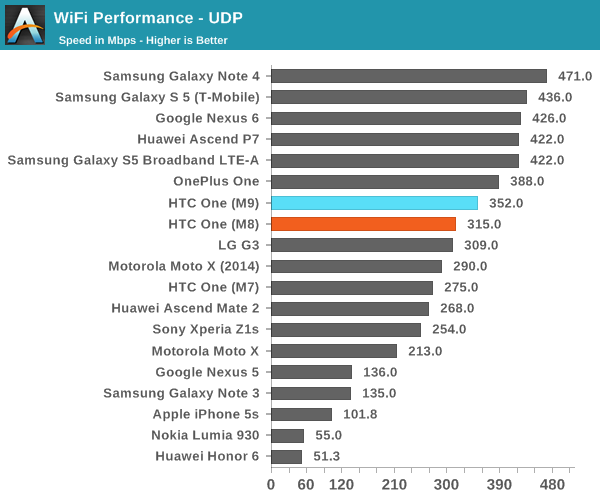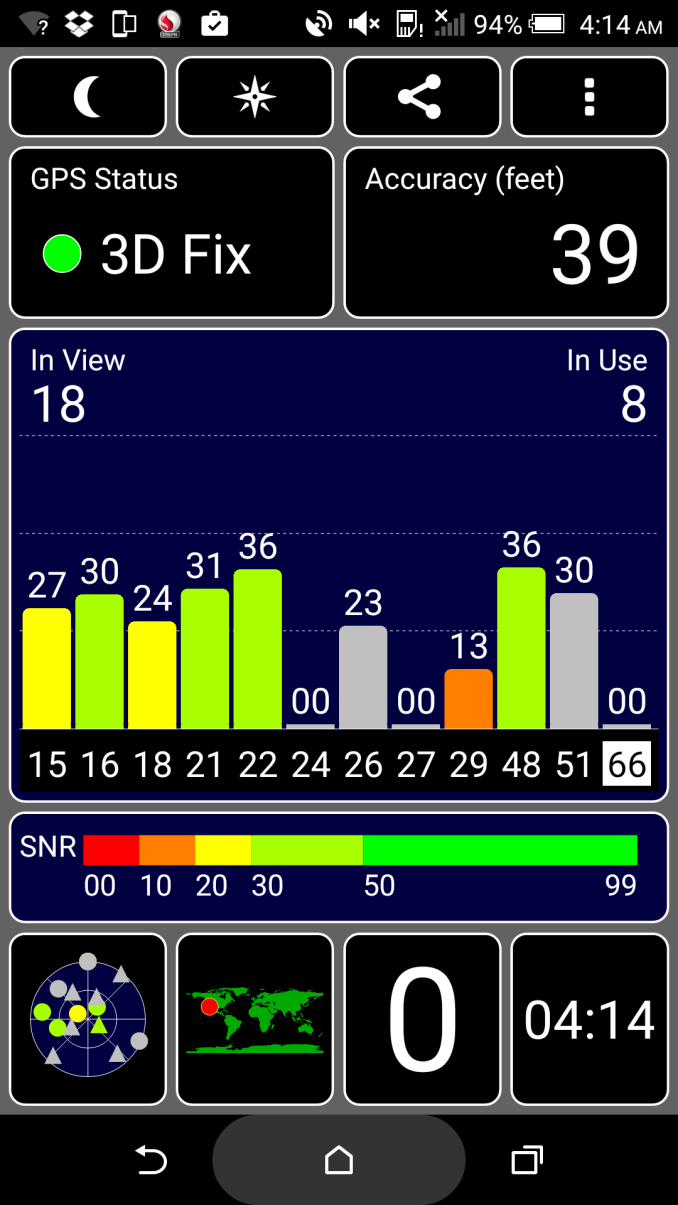The HTC One M9 Review: Part 2
by Joshua Ho on April 6, 2015 10:00 AM EST- Posted in
- Smartphones
- HTC
- Qualcomm
- Mobile
- Snapdragon 810
- One M9
WiFi Performance
Fundamentally, a smartphone is defined by its ability to connect to the internet. Although cellular data is important, WiFi performance is crucial for anyone on a limited data plan and in areas where cellular data is slow or nonexistent. To this end, HTC has outfitted the One M9 with Broadcom’s BCM4356 WiFi/BT combo chipset, which we’ve seen before in the Nexus 6. This chipset supports 2x2 802.11ac, but the One M9 only supports a maximum 433 Mbps physical link rate, which means that it’s only using a single spatial stream. I haven’t been able to find any information on the antenna configuration of the One M9, but it’s likely that HTC is only using a single antenna for WiFi on the One M9 which would make it similar to the One M7 and One M8 in that regard. In order to test how this configuration performs, we use IPerf on Android connected to a PC to see how rapidly the device can send UDP packets.

As one can see, there’s a reasonable performance uplift when compared to Qualcomm Atheros’ WCN3680 WiFi/BT combo chip, but it isn’t as big as moving to a 2x2 MIMO configuration. The lack of MIMO also has implications for WiFi range, but WiFi signals degrade quickly enough that this wouldn’t be a massive difference.
GNSS
As the One M9 uses a Qualcomm modem, it's a pretty safe bet that it also uses the modem for GNSS location services. In practice, this means that the One M9 locks on to satellites quickly any time it's possible to download assistance data to speed up GPS.
Without assistance data, the One M9 seems to have worse performance than expected, although weather conditions can always affect overall performance. Time to first lock took a minute and 42 seconds, and accuracy wasn't quite as high as one would hope, tending towards 30 foot accuracy rather than 10 foot accuracy. It's likely that local weather conditions were responsible for this issue, as subjectively it seemed that GPS performance was comparable to other phones tested at the same time.











127 Comments
View All Comments
blanarahul - Tuesday, April 7, 2015 - link
This will be a big problem going forward. Look at Mali T760MP6 on Exynos 5433. Going from 600 MHz to 700 MHz requires a tremendous amount of power. The GHz race could only work till 28 NM it seems. The only solution to improve performance/watt is to go wider.TylerGrunter - Tuesday, April 7, 2015 - link
I can't completely agree with your statement. The issue is that to go to 20nm they should have used FinFet to reduce the current leakage at high frequencies. They didn't (neither GF, Samsung or TSMC) and that has been the consequence: 20nm doesn't scale well at high frequencies.Intel has managed to clock cores till 3.5 GHz already in 14nm FinFet, so with FinFet there shouldn't have the same issue.
By the way: I suspect NVidia had the same issue with the Denver cores and therefore they decided to go with A57 at 20nm.
But I agree that in most of the cases they should go wider (or increase IPC in some other way) in mobile. Even the A57 has only 3 paths.
Frenetic Pony - Tuesday, April 7, 2015 - link
Sure, but apparently finfet is harder for everyone that's not Intel. But Samsung, GloFo, and TSMC all now have Finfet up and running. At 3 years behind Intel for a similar enough feature density, and considering how hard Intel found shrinking their feature size once again, one wonders how long it will take these other 3 to get to a new process node after this. > 2 years is my guess.Alternate materials with less voltage leak and higher electron mobility are really, really needed and I don't understand why more isn't invested into them, other than uninformed executives making the decisions for future investment rather than engineers. 10nm (as in 2 actual feature size shrinks from 22/20nm) is doable with optical tools. But beyond that there are multiple new tools and techniques that need to fight vastly increasing complications and quality needed. The end of Moore's law is indeed within sight.
frenchy_2001 - Tuesday, April 7, 2015 - link
10nm is actually really hard.Either you do quad patterning (write 4 times slightly offset), which is less than trivial (you cannot make each step too wide and you will chip at it to prepare before the next) or you jump to extreme UV, and no one is there yet.
Intel has been spending a lot of time and money in solving those problems for years and they are STILL not solved...
KiretoX - Monday, April 6, 2015 - link
Page 2 table, M9 read camera... OV4688... not Toshiba?Andrei Frumusanu - Monday, April 6, 2015 - link
Fixed the table, thank you.Darkito - Monday, April 6, 2015 - link
RIP HTCnathanddrews - Monday, April 6, 2015 - link
Rip in peace, HTC.blanarahul - Tuesday, April 7, 2015 - link
Dafuq?!Armourcore9brker - Monday, April 6, 2015 - link
You should try setting the camera the way that was done in this XDA thread: http://forum.xda-developers.com/showpost.php?p=598...It seems like setting the ISO too high is causing a lot of the problems.